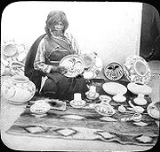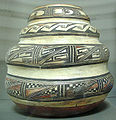
Nampeyo
Encyclopedia


Hopi
The Hopi are a federally recognized tribe of indigenous Native American people, who primarily live on the Hopi Reservation in northeastern Arizona. The Hopi area according to the 2000 census has a population of 6,946 people. Their Hopi language is one of the 30 of the Uto-Aztecan language...
potter who lived on the Hopi Reservation
Hopi Reservation
The Hopi Reservation, or simply Hopi, is a Native American reservation for the Hopi and Arizona Tewa people, surrounded entirely by the Navajo Nation, in Navajo and Coconino counties of Arizona, USA. The site in north-eastern Arizona has a land area of 2,531.773 sq mi and as of the 2000 census had...
in present-day Arizona
Arizona
Arizona ; is a state located in the southwestern region of the United States. It is also part of the western United States and the mountain west. The capital and largest city is Phoenix...
. She received the English name Iris as an infant, but was better known by her Tewa
Tewa language
Tewa is a Kiowa–Tanoan language spoken by Pueblo people, mostly in the Rio Grande valley in New Mexico north of Santa Fe. The 1980 census counted 1,298 speakers, almost all of whom are bilingual in English...
name, Num-pa-yu, meaning "snake that does not bite".
She was born at Hano
Arizona Tewa
The Arizona Tewa are a Tewa Pueblo group that resides on the eastern part of the Hopi Reservation on or near First Mesa in northeastern Arizona.-Synonymy:...
Pueblo
Pueblo
Pueblo is a term used to describe modern communities of Native Americans in the Southwestern United States of America. The first Spanish explorers of the Southwest used this term to describe the communities housed in apartment-like structures built of stone, adobe mud, and other local material...
, which is primarily made up of descendants of the Tewa tribe who fled west to Hopi lands after the Pueblo Rebellion
Pueblo Revolt
The Pueblo Revolt of 1680, or Popé's Rebellion, was an uprising of several pueblos of the Pueblo people against Spanish colonization of the Americas in the province of Santa Fe de Nuevo México.-Background:...
of 1680. Her mother, Ootca-ka-o was Tewa; her father Qots-vema, from nearby Walpi
Walpi
Walpi is a village in Navajo County, Arizona, north east of Flagstaff. It is on First Mesa in the Hopi Reservation. It is inhabited mainly by the Hopi-speaking Pueblo , several of whom live without running water or electricity. Walpi is one of the oldest continuously inhabited villages in the...
Pueblo
Pueblo
Pueblo is a term used to describe modern communities of Native Americans in the Southwestern United States of America. The first Spanish explorers of the Southwest used this term to describe the communities housed in apartment-like structures built of stone, adobe mud, and other local material...
, was Hopi.
Hopi people make ceramics painted with beautiful designs, and Nampeyo was eventually considered one of the finest Hopi potters. Nampeyo learned pottery making through the efforts of her paternal grandmother. In the 1870s, she made a steady income by selling her work at a local trading post operated by Thomas Keam. She became increasingly interested in ancient pottery form and design, recognizing them as superior to Hopi pottery produced at the time. Her second husband, Lesou (or Lesso) was employed by the archaeologist J. Walter Fewkes
J. Walter Fewkes
Jesse Walter Fewkes was an American anthropologist, archaeologist, writer and naturalist. He was born in Newton, Massachusetts, and initially trained as a zoologist at Harvard University...
at the excavation of the prehistoric ruin of Sikyátki
Sikyátki
Sikyátki is an archeological site and former Hopi village spanning 40,000 to 60,000 square metres on the eastern side of First Mesa, in what is now Navajo County in the U.S. state of Arizona. It was inhabited by Kokop clan of the Hopi from the 14th to the 17th century. Jesse Walter Fewkes led a...
in the 1890s. Lesou helped Nampeyo find shards showing the old forms and Fewkes produced detailed illustrations of reconstructed pots.
Nampeyo developed her own style based on the traditional designs. Her work was purchased for the Smithsonian Institution
Smithsonian Institution
The Smithsonian Institution is an educational and research institute and associated museum complex, administered and funded by the government of the United States and by funds from its endowment, contributions, and profits from its retail operations, concessions, licensing activities, and magazines...
and by collectors worldwide. In 1904 and 1907, she produced and sold pottery at the Grand Canyon
Grand Canyon
The Grand Canyon is a steep-sided canyon carved by the Colorado River in the United States in the state of Arizona. It is largely contained within the Grand Canyon National Park, the 15th national park in the United States...
lodge owned by the Fred Harvey Company
Fred Harvey Company
The origin of the Fred Harvey Company can be traced to the 1875 opening of two railroad eating houses located at Wallace, Kansas and Hugo, Colorado on the Kansas Pacific Railway. These cafés were opened by Fred Harvey, then a freight agent for the Chicago, Burlington and Quincy Railroad...
. She and her husband traveled to Chicago in 1898 and 1910 to display her work.
Nampeyo began to lose her sight in 1925, but continued to form and shape pots by touch. These later pots were painted by members of her family, including her four daughters, who also became well-known potters. She worked with clay until her death in 1942.
Nampeyo's photograph was often used as a symbol of the Hopi people and, by the end of her life, she was drawing huge numbers of tourists to her workshop. Her influence led to a renewal of the pottery-making tradition among the Hopi and to the elevation of traditional pottery forms and decoration to an art form.
See also
- Fannie NampeyoFannie NampeyoFannie Nampeyo was a modern and contemporary fine arts potter, who carried on the traditions of her famous mother, Nampeyo of Hano, the grand matriarch of modern Hopi pottery.Fannie was the youngest, and perhaps the most famous, of Nampeyo of Hano's three daughters...
, daughter - Elva NampeyoElva NampeyoElva Nampeyo was an American studio potter. She was born in the Corn Clan house where her grandmother Nampeyo resided, atop Hopi First Mesa. She was the daughter of Fannie Nampeyo and Vinton Polacca. As a child Elva would watch her grandmother make pottery and play with the clay...
, granddaughter - Dextra Nampeyo Quotskuyva, great-granddaughter
External links
- A Nampeyo Timeline, from the Arizona State Museum at the University of ArizonaUniversity of ArizonaThe University of Arizona is a land-grant and space-grant public institution of higher education and research located in Tucson, Arizona, United States. The University of Arizona was the first university in the state of Arizona, founded in 1885...
- A Nampeyo Showcase, a display of some of Nampeyo's work
- Photographic Resources Guide to the North American Collection, Thomas Keam's Southwest Expedition
- Nampeyo - Hopi master potter

